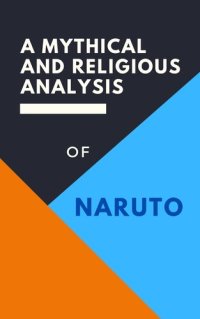
Ebook: Naruto: A Mythical and Religious Analysis
Author: Anonyous
- Year: 2023
- Publisher: Published in the public domain
- Edition: 2
- Language: English
- pdf
A guide to the mythical and religious elements of the Naruto series.
A book that serves as a side-by-side commentary on the first season and Shippuden.
Overview of the information in some major chapters
Chapter 1: Land of Waves
- Inari Mythology
- The Kitsune in Japanese Folklore
- Kakashi vs Zabuza being a modernisation of Miyamoto Musashi and Sasaki Kojiro
Chapter 5: Naruto vs Neji
- The role of Confucian values in shaping the Hyuga clan
- The adaptations of The Journey to the West, in terms of narrative value and characterisation of Naruto
- The role that Taoism plays in providing an answer to Neji
Chapter 7: Sannin Showdown
- Adaptation of The tale of the Gallant Jiriaya for the three Sannin
- How the story also influences the Konoha crush arc
Chapter 8: Sasuke leaves the village
- The possibility of the Egyptian Mythology of Osiris being a significant shaping of Sasuke's character, and the Myths of
Horus shaping Sasuke in early Shippuden.
- The nihilistic differences in Kimimaro and the old Neji
Chapter 14: Brothers between battle
- The story of the Shinto god Susanoo and the story of Yamata-no-Orochi being featured
- Sasuke's personfication of Amaterasu
- How the cave of Amaterasu's entrapment has been modernised in correspondence with the ideas of Plato's cave
Chapter 16: Pain
- The symbolism of Christ developing to fight Pain on his own
- The psychological symbolisms found in Western alchemy, mapping onto Naruto's descent into hell
- Naruto's TnJ with Nagato bearing resemblance to Dostoyevsky's The Brothers Karamazov
Chapter 20: Tests of Character
- Zetsu's correspondence to the alchemical symbolism of the mandrake
- How this carries over into the ideas of the homunculus, with Zetsu and Naruto articulating two different types
Chapter 25: Squad 7 Reunited
- The history of Indra and the Asuras in Hinduism
- The combination of select Yokai and Shugendo rituals which forms the idea of the Ten-Tails
- The history of Shugendo influencing Ninshu, and the division between Hagoromo's children Indra and Ashura
Chapter 26: Endgame
- Kaguya being adapted from The tale of the Bamboo cutter
- The story of the Chinese Goddess of the moon and the elixir corresponding to the divine fruit
- The story of Obito's redemption (also see Chapter 22.)
A book that serves as a side-by-side commentary on the first season and Shippuden.
Overview of the information in some major chapters
Chapter 1: Land of Waves
- Inari Mythology
- The Kitsune in Japanese Folklore
- Kakashi vs Zabuza being a modernisation of Miyamoto Musashi and Sasaki Kojiro
Chapter 5: Naruto vs Neji
- The role of Confucian values in shaping the Hyuga clan
- The adaptations of The Journey to the West, in terms of narrative value and characterisation of Naruto
- The role that Taoism plays in providing an answer to Neji
Chapter 7: Sannin Showdown
- Adaptation of The tale of the Gallant Jiriaya for the three Sannin
- How the story also influences the Konoha crush arc
Chapter 8: Sasuke leaves the village
- The possibility of the Egyptian Mythology of Osiris being a significant shaping of Sasuke's character, and the Myths of
Horus shaping Sasuke in early Shippuden.
- The nihilistic differences in Kimimaro and the old Neji
Chapter 14: Brothers between battle
- The story of the Shinto god Susanoo and the story of Yamata-no-Orochi being featured
- Sasuke's personfication of Amaterasu
- How the cave of Amaterasu's entrapment has been modernised in correspondence with the ideas of Plato's cave
Chapter 16: Pain
- The symbolism of Christ developing to fight Pain on his own
- The psychological symbolisms found in Western alchemy, mapping onto Naruto's descent into hell
- Naruto's TnJ with Nagato bearing resemblance to Dostoyevsky's The Brothers Karamazov
Chapter 20: Tests of Character
- Zetsu's correspondence to the alchemical symbolism of the mandrake
- How this carries over into the ideas of the homunculus, with Zetsu and Naruto articulating two different types
Chapter 25: Squad 7 Reunited
- The history of Indra and the Asuras in Hinduism
- The combination of select Yokai and Shugendo rituals which forms the idea of the Ten-Tails
- The history of Shugendo influencing Ninshu, and the division between Hagoromo's children Indra and Ashura
Chapter 26: Endgame
- Kaguya being adapted from The tale of the Bamboo cutter
- The story of the Chinese Goddess of the moon and the elixir corresponding to the divine fruit
- The story of Obito's redemption (also see Chapter 22.)
Download the book Naruto: A Mythical and Religious Analysis for free or read online
Continue reading on any device:

Last viewed books
Related books
{related-news}
Comments (0)